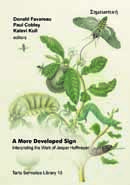The institution of semiotics in Estonia
The institution of semiotics in Estonia
Author(s): Mihhail Lotman, Peeter Torop, Kalevi Kull, Silvi SalupereSubject(s): Language and Literature Studies
Published by: Tartu Ülikooli Kirjastus
Summary/Abstract: The article gives a historical overview of the institutional development of semiotics in Estonia during two centuries, and describes briefly its current status. The key characteristics of semiotics in Estonia include: (1) seminal role of two world-level classics of semiotics from the University of Tartu, Juri Lotman and Jakob von Uexküll; (2) the impact of Tartu–Moscow school of semiotics, with a series of summer schools in Kääriku in 1960s and the establishment of semiotic study of culture; (3) the publication of the international journal Sign Systems Studies, since 1964; (4) the development of biosemiotics, notably together with colleagues from Copenhagen; (5) teaching semiotics as a major in bachelor, master, and doctoral programs in the University of Tartu, since 1994; (6) a plurality of institutions — in addition to the Department of Semiotics in the University of Tartu, several supporting semiotic institutions have been established since 1990s; and (7) a wide scope of research in various branches of semiotics, including theoretical studies, empirical studies, and applied semiotics projects on governmental and other request.
Journal: Σημειωτκή - Sign Systems Studies
- Issue Year: 39/2011
- Issue No: 2-4
- Page Range: 314-342
- Page Count: 29
- Language: English

